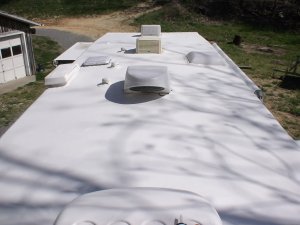Identifying the Roof Membrane Before an RV Rubber Roof Replacement
A solid and reliable RV roof is important if you want to continue enjoying your mobile home without the hassles brought by an inadequate roofing. A basic knowledge of the different types of RV roofs is crucial if you want to care for your roof.
There are basically three types of materials that your RV roof could be made of—metal, fiberglass or rubber. Identifying a metal roof is fairly easy. While they are not common these days, metal roofs such as galvanized metal and aluminum were widely used decades ago. Fiberglass roofs are also becoming rarer nowadays.
Around 20 years ago the RV industry found a new type of roofing material that works better than metals or fiberglass and has qualities not found in the old roofs. The product is a rubber roofing membrane that is lightweight, cost-effective, easy to install and maintain, seamless and resistant to UV light.
EPDM and TPO Rubber Roofs
The two popular types of RV rubber roofing are EPDM (Ethylene Propylene Diene Monomer) and TPO (Thermal Poly Olefin). If your RV has a rubber roof, it could either be EPDM or TPO. When the time comes when you need to have an RV rubber roof replacement, you should be able to identify the type of rubber your RV has in order to install the right material.
How do you know which type of rubber roof is installed on your RV?
Check Owner’s Manual
The first thing you should consult is the RV owner’s manual. It should plainly state what type of rubber membrane was used on the RV. It will also lists the maintenance and cleaning instructions for your RV. If you have no access to the owner’s manual or for some reasons it does not specify the type of rubbing membrane used, there are ways to determine the type of your RV rubber roofing.
Gray or White Streaks
Look for gray or white streaks on the sides of the RV. EPDM membrane is designed to oxidize over time to protect it against UV rays and ozone. The oxidization or shedding produces the gray or white streaks found on the body of the RV.
Unlike EPDM, TPO rubber roof does not oxidize so you will not see any white or gray streaks on the sides of the RV. Another characteristic of a TPO membrane not found in EPDM is its glossy look.
Slippery When Wet
Another difference between the two types of rubber roofing is that EPDM is very slippery when wet while TPO is not.
